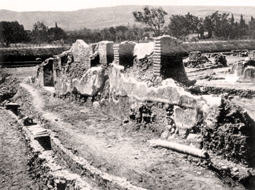scarica l’articolo in formato pdf: La rete idrica della Kos di età romana: persistenze e modificazioni rispetto alla città ellenistica
.
 Nella città di Kos, durante gli scavi che impegnarono gli archeologi italiani tra il 1912 e il 1945 e nei nuovi scavi del Servizio Archeologico greco, è stato messo in luce un complesso sistema di approvvigionamento dell’acqua basato sull’integrazione in età romana di una rete idrica già impostata fin dalla fondazione della città, avvenuta nel 366 a.C. sulla base di un piano urbano di tipo ippodameo che definiva anche un sistema di canali per lo smaltimento delle acque meteoriche progettato insieme alla rete viaria. L’approvvigionamento idrico, invece, poteva contare sulle abbondanti sorgenti naturali site sulle colline a sud-est della città, integrato da cisterne e pozzi privati. I punti di utilizzo comprendevano fontane pubbliche e ninfei, e, in età romana, soprattutto diversi edifici termali, databili nel loro primo impianto tra I e II sec. d.C., con successivie trasformazioni che li videro funzionanti almeno fino alla metà del IV secolo. Per alimentare gli impianti termali, in età imperiale venne costruito un acquedotto, anche se le terme sono sempre dotate di serbatoi di accumulo per compensare eventuali riduzioni del flusso; l’acqua di scarico delle vasche termali andava poi ad alimentare i condotti di smaltimento delle latrine pubbliche, sempre realizzate nelle loro immediate adiacenze, mentre anche le case private erano dotate di impianti igienici che scaricavano nei condotti di drenaggio al centro delle strade, rifacimenti più tardi degli originari canali di età protoellenistica. In conclusione, i sistemi di approvvigionamento idrico e smaltimento delle acque di scarico testimoniano a Kos la notevole persistenza degli originari sistemi idrici della città e soprattutto attestano come lo studio dei sistemi idrici di una città possa fornire dati utili alla conoscenza della sua topografia nelle diverse fasi di sviluppo.
Nella città di Kos, durante gli scavi che impegnarono gli archeologi italiani tra il 1912 e il 1945 e nei nuovi scavi del Servizio Archeologico greco, è stato messo in luce un complesso sistema di approvvigionamento dell’acqua basato sull’integrazione in età romana di una rete idrica già impostata fin dalla fondazione della città, avvenuta nel 366 a.C. sulla base di un piano urbano di tipo ippodameo che definiva anche un sistema di canali per lo smaltimento delle acque meteoriche progettato insieme alla rete viaria. L’approvvigionamento idrico, invece, poteva contare sulle abbondanti sorgenti naturali site sulle colline a sud-est della città, integrato da cisterne e pozzi privati. I punti di utilizzo comprendevano fontane pubbliche e ninfei, e, in età romana, soprattutto diversi edifici termali, databili nel loro primo impianto tra I e II sec. d.C., con successivie trasformazioni che li videro funzionanti almeno fino alla metà del IV secolo. Per alimentare gli impianti termali, in età imperiale venne costruito un acquedotto, anche se le terme sono sempre dotate di serbatoi di accumulo per compensare eventuali riduzioni del flusso; l’acqua di scarico delle vasche termali andava poi ad alimentare i condotti di smaltimento delle latrine pubbliche, sempre realizzate nelle loro immediate adiacenze, mentre anche le case private erano dotate di impianti igienici che scaricavano nei condotti di drenaggio al centro delle strade, rifacimenti più tardi degli originari canali di età protoellenistica. In conclusione, i sistemi di approvvigionamento idrico e smaltimento delle acque di scarico testimoniano a Kos la notevole persistenza degli originari sistemi idrici della città e soprattutto attestano come lo studio dei sistemi idrici di una città possa fornire dati utili alla conoscenza della sua topografia nelle diverse fasi di sviluppo.
.
In the town of Kos, the excavations carried out by the Italian archaeologists between 1912 and 1945 and the new investigations by the Greek Archaeological Service have revealed a complex system of water supply based on the integration, occurred during the Roman period, of a water network already set up since the foundation of the city, that took place in 366 BC on the basis of an urban Hippodamian scheme; this defined also a urban drainage system for the disposal of stormwater designed together with the road network. The water supply could rely on abundant natural springs located in the hills south-east of the city, supplemented by private wells and cisterns. The water usage involved public fountains and nymphaea, and, especially in Roman times, several bath buildings, whose first installation dates in a period between I and II cent. AD, with later changes until the mid-fourth century, when some of them changed their function and were transformed in religious buildings. To fed the thermae, an aqueduct was built in imperial period, although the baths were always equipped with storage tanks to compensate any reduction of the flow; to rationalize the use of water, the discharge of the thermal baths was conducted through pipes to flush the sewers of public latrines, always built nearby, while the houses were equipped with private sanitary facilities whose sewers used the drainage channels in the middle of the streets, later reworkings of the original channels of the first Hellenistic age. In conclusion, the water supply systems and wastewater disposal witness the remarkable persistence of the original Kos town water systems and above all attest to how the study of water management systems of a city may improve knowledge of its topography at the different stages of development.
